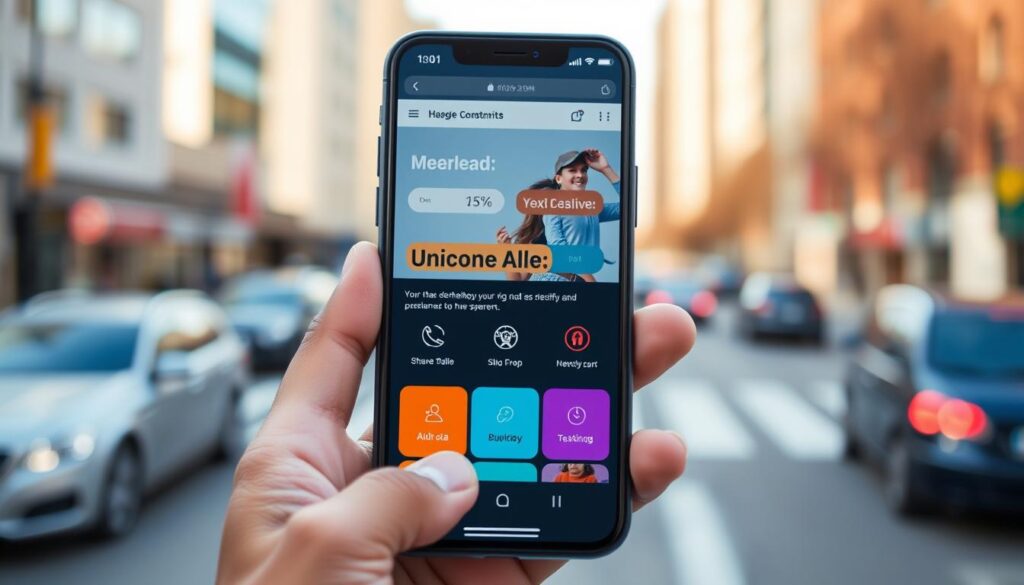As the digital world grows, making your site mobile-friendly is now essential. Mobile devices are used more than desktops for surfing the web. This shows how important it is to focus on mobile-first. With more than half of the web traffic coming from mobile devices, mobile optimization is key.
Mobile searches are beating desktop searches. This makes perfect mobile performance a must. Not only is it important for ranking in search engines like Google and Bing, but it also affects search results. Mobile searches often show different results than desktop, focusing more on local info.
Optimizing for mobile isn’t just about meeting technical needs. It’s also about giving users a smooth and fast experience on their phones. GreenPal’s CEO, Bryan Clayton, proves that a well-optimized mobile site makes converting visitors easier.
Making your website mobile-friendly can keep your customers coming back. This is because users want quick load times and easy-to-navigate sites. To improve mobile optimization, follow Google’s responsive design tips and update your business info. By focusing on mobile, you can improve your site’s visibility, user involvement, and conversions.
Key Takeaways
- Mobile optimization is no longer optional; it’s a definitive requirement for modern web presence.
- Responsive design is crucial for accommodating a variety of devices and screen sizes.
- Speed is paramount—most mobile users expect a site to load in three seconds or less.
- Local search optimization is vital for location-based businesses to stand out.
- Technical elements like meta tags, CSS, and image optimization play significant roles in mobile UX.
- Google’s mobile-first index makes mobile optimization essential for SEO.
Understanding the Importance of Mobile Optimization
In our digital world, making websites fit for mobile users is key. It helps boost mobile search rankings and greatly enhances user experience on mobile. Mobile optimization’s need is clear, seeing the rise of mobile traffic and issues with sites that aren’t mobile-friendly.
Mobile Usage Statistics in 2023
Now, over 55% of web traffic comes from mobile, not counting tablets. The move to mobile web use is evident. An impressive 92.3% of people use mobiles to go online. This underlines the importance for sites to serve these users well. By 2025, it’s expected that shopping via mobile will hit nearly $710 billion. This huge change shows why businesses must enhance user experience on mobile to keep up.
The Impact of Mobile Speed on User Experience
For mobile sites, speed is vital. Even a one-second delay can cut conversions by 7%. Mobile site speed is so important that Google now prefers mobile-friendly sites for its rankings. To stay visible in searches, optimizing mobile site speed is crucial. AMP pages help here by loading fast on mobile, improving user satisfaction and conversion rates.
Using tools to analyze user behavior on mobile sites gives clues for improvement. Focusing on Calls-To-Action (CTAs) and forms can really help. A mobile site that is quick, easy to use, and secure is more likely to turn visitors into customers.
Key Elements of Mobile Optimization
As the digital world grows, making websites work well on mobile devices is more important than ever. This part discusses what web designers and developers must do to make sure their sites work great on mobile.
Responsive Web Design Principles
Responsive web design is crucial for mobile-friendly sites. It makes sure websites look good on all screens. This not only helps users but also boosts a site’s rank on search engines. It involves using flexible images, fluid layouts, and CSS media queries.
The Role of Viewport in Mobile Design
The viewport plays a big role in mobile design because it helps adjust the content for different screens. Setting it right means users won’t have to zoom or scroll sideways to read the content. This makes for a much better experience.
Using a viewport meta tag is a key step in mobile optimization. It helps make sure your site looks good on mobile browsers. Without it, your site could appear too big or too small, which can turn users away.
| Statistic | Impact on Mobile Optimization |
|---|---|
| 84% of people use smartphones as their primary browsing device. | This highlights why designs need to be mobile-first, focusing on the majority of web users. |
| Mobile browsing accounts for over 60% of web traffic. | This shows the importance of making websites work smoothly on mobile devices. |
| 96% to 18% reduction in abandonment rate post mobile-first redesign. | This indicates that focusing on mobile can greatly improve user retention and happiness. |
| Mobile-friendly redesign led to increased site engagement. | This suggests that a better mobile experience makes users more likely to engage. |
| 53% of users abandon sites that take over three seconds to load on mobile. | This stresses the need for fast loading times to keep users from leaving your site. |
These principles and stats show why it’s essential to keep improving mobile sites. By working on these areas, developers and designers can boost engagement, SEO rankings, and conversions.
Best Practices for Mobile-Friendly Content
To truly improve mobile SEO, you need a special approach for mobile users. A big part of online traffic is now from mobile devices. It’s crucial to meet these users’ needs to stay relevant. We’ll show you strategies that make your content more mobile-friendly. This boosts engagement and conversion rates on your site.
Writing for Mobile Readability
Readability is key for mobile content. Your text must be clear, brief, and engaging. Make sure it’s easy to read. For better mobile SEO best practices, use short paragraphs and bullet points. Adding subheadings can also help. This format lets users easily scan your content on small screens.
- Avoid long sentences that overwhelm mobile readers.
- Break complex ideas into bullet points for easy understanding.
- Use bold or italics to highlight important points.
A staggering 74% of users prefer websites that are mobile-friendly. Making your site easy to read on mobiles can win you more visitors. It helps you stand out and encourages people to come back.
Formatting Text and Images for Mobile
Correct formatting of text and images is crucial to improve mobile SEO. Images must load fast but still look good. Mobile users don’t like to wait. Make sure your content looks good and images add value. Keep everything nice and structured.
| Mobile User Need | Formatting Strategy | Impact on User Experience |
|---|---|---|
| Quick Information Access | Bullet points, clear headers | Improves scanning ability, retains users |
| Image Clarity | Optimized, responsive images | Decreases load time, increases engagement |
| Text Legibility | Larger fonts, increased spacing | Enhances readability, reduces strain |
Formatting your content for mobile can really help your mobile SEO. It makes your site more user-friendly. Following these tips can exceed mobile users’ expectations.
Accelerated Mobile Pages (AMP) Explained
Launched by Google in 2015, Accelerated Mobile Pages (AMP) makes mobile sites perform better and load faster. It works by optimizing a webpage’s structure for speedy loading. This boosts user engagement, very important as more people use mobile devices worldwide.
Benefits of Implementing AMP
AMP brings big benefits, especially in speed. If a site loads slowly, over 40% of people will leave it. But AMP sites load super quick, in less than a second, which means fewer people leave the site. This is crucial because there are over 30 billion mobile moments daily in the U.S.
AMP also helps make more money from ads. Mobile pages that load in 5 seconds earn twice as much ad money than ones that take 19 seconds. Plus, AMP helps your site show up more in Google searches. This means more people visit your site, improving your site’s SEO results.
How to Create AMP Pages
Creating an AMP site means following certain rules. You must use a simplified CSS and AMP’s own JavaScript. This method ensures the site works well on mobile devices and loads very quickly. Often, an AMP page loads in half a second. This fast load time keeps online users happy and engaged.

| Aspect | Improvement Percentage |
|---|---|
| Website Traffic | 10% increase |
| Engagement Rate | 35% higher |
| Sales and Conversions | 20% increase |
| Load Time | Up to 4x faster |
| Ad Revenue | 2x more revenue |
AMP changes more than just load times and efficiency. It also boosts sales and conversions by 20% for e-commerce sites using AMP. This switch creates faster, better mobile experiences. It meets the demands of modern mobile users. And it helps online businesses succeed financially.
The Role of Analytics in Mobile Optimization
Analytics are key in making mobile sites better. They help improve the way mobile websites perform. As more people use mobile devices to go online, businesses need analytics. This helps create better experiences for users and increase engagement.
Tracking Mobile User Behavior
It’s vital to know how users interact with your mobile website. Analytics give insights into actions users take on your site. Things like how long they stay, what they look at, and their journey matter. This helps figure out if your mobile website is easy to use.
Key Metrics to Monitor
For a better mobile site, you need to watch certain metrics:
- Session Duration: Shows how long users stay. It tells us if they’re interested.
- Bounce Rate: If this is high, it means your site might not grab visitors right away.
- Conversion Rates: This shows if visitors are buying or signing up. It’s important for your success.
- Page Load Times: If pages load slowly, people may leave. Keeping pages quick is crucial.
| Plan | Cost Per Month | Cost Per Year | Monthly Sessions |
|---|---|---|---|
| FullSession Starter | $39 | $32 | 5,000 |
| FullSession Business | $75 | $60 | 100,000 |
Using analytics to upgrade mobile optimization is smart. Constantly checking important metrics helps. This way, businesses can make user experiences better. Doing so increases chances for more conversions and keeps them ahead in a mobile-first world.
Tools to Enhance Mobile Optimization
Today’s world is ruled by mobile internet. So, getting the right tools to boost mobile optimization is key for success. Companies need to focus on mobile optimization to engage users, increase sales, and rank high on search engines.
Responsive Design Testing Tools
With so many mobile devices out there, giving everyone a good experience is a must. Responsive design testing tools let us see how websites look on various screens. This ensures everything works perfectly on any device. BrowserStack and Google’s Mobile-Friendly Test help check a site’s responsive design and find any issues.
Performance Optimization Tools
How fast a mobile site loads is super important for keeping users happy and doing well in SEO. Optimization tools help make websites fast on mobiles. They work by optimizing images, shrinking JavaScript and CSS files, and using browser caching. GTmetrix and Google PageSpeed Insights give tips to speed up your website.
Keeping your mobile site in top shape means continually updating and testing it. WPtouch and Jetpack are great for boosting site speed, and themes like Divi make sure your design looks good on all devices. W3 Total Cache and WP Smush are excellent for squeezing out extra performance, making the mobile experience even better.

Future Trends in Mobile Optimization Strategies
The digital world is always changing, and so are ways to make mobile sites better. Now, most people buy things online using their phones. In fact, about 60% of online sales globally come from mobile devices in 2023. This shows how important it is for websites to work well on phones.
Companies like Nostra know this trend well. About 80% of their sales come from mobile users. They’re leading the way with new tech like the Edge Delivery Engine™. This tool makes sites load 20-30% faster, especially on a 5G connection. Businesses must keep up with these changes to stay ahead.
Artificial Intelligence and Mobile Design
Artificial intelligence (AI) is changing how we make websites better for phone users. It offers personalized content that reacts to what users like and do. Thanks to AI, people are more engaged with websites and end up buying more.
Once, having a site that changes layout for phones was a big deal. Now, it’s a must-have for online stores. This not only makes visiting the site a better experience but also helps more people find the site. This is very important now that Google focuses on mobile-friendly sites first.
The Rise of Voice Search and Its Implications
Voice search is becoming a big thing for SEO. In the U.S., nearly everyone goes online using their phones. More and more, people use voice search, needing websites to understand natural, spoken questions. It’s key for websites to be easy to use on phones, especially since users leave if a site doesn’t load fast.
Failure to adapt to mobile users has big consequences. If a mobile site isn’t good, about 57% of people won’t suggest the business to others. This affects not only finding new customers but keeping current ones happy.
Learning about mobile optimization is crucial for any business wanting to succeed online. Check out this detailed article on mobile optimization for tips on how to do it right.
FAQ
What are effective ways to enhance mobile optimization strategies?
To boost mobile optimization, start with a mobile-friendly design. Quick load times are also key. Use responsive design to fit all screens.
Optimize your content for small screens. Stay updated on mobile SEO practices. Tools like AMP can speed up your mobile site.
Why is mobile optimization increasingly important in 2023?
More people now surf the web on mobile devices. A mobile-optimized site offers better user experience. It’s key for good mobile SEO.
Google also prefers websites that look great on mobile. They use mobile-first indexing to rank sites.
How does mobile site speed impact user experience?
Fast mobile sites make users happy. If your site is slow, people may leave. This can hurt your sales and rankings.
What are the principles of responsive web design?
Responsive design aims to make sites look good on any device. It uses fluid grids and flexible images. Media queries help adjust to any screen size.
How does the viewport contribute to mobile design?
The viewport ensures websites look good on mobile. It scales and sizes content properly. This makes sites easy to read without zooming.
What should be considered when writing content for mobile?
Keep mobile content short and scannable. Use bullet points and subheadings. Include images and keep text blocks brief.
Make sure your content is engaging for people on the go.
How do images need to be formatted for mobile?
Optimize images for fast loading on mobile. Compress them without losing quality. Match their size to mobile screens for a better experience.
What are the benefits of Accelerated Mobile Pages?
AMP speeds up page loading. It can lower bounce rates and boost engagement. AMP pages often rank higher in mobile searches, drawing more visitors.
What is involved in creating AMP pages?
Creating AMP pages means using streamlined HTML. A special JavaScript framework ensures they load quickly. An AMP cache delivers content efficiently.
How can analytics help in mobile optimization?
Analytics reveal how users interact with mobile sites. They show what’s working or not. Use them to improve your site’s performance.
What mobile user behavior should be tracked?
Watch how long people stay, how they navigate, and react to calls to action. Analyze the content they prefer. This helps tailor the user experience.
What are key performance metrics in mobile analytics?
Focus on bounce rates, conversion rates, load times, and how long visits last. These metrics gauge the mobile experience. They highlight areas needing work.
Which tools are vital for responsive design testing?
Tests with Google’s Mobile-Friendly Test, BrowserStack, and Screenfly are crucial. They ensure your site adapts well to various devices.
What tools and techniques improve mobile website performance?
To speed up your site, use image compression, caching, and minifying code. A CDN also helps. These improve loading times and user experience on mobile.
How might AI influence mobile design in the future?
AI could personalize mobile experiences. It may automate site optimizations based on user behavior. AI can also update content in real-time, suited to user needs.
What does the rise of voice search mean for mobile SEO?
With more voice searches on mobile, sites must optimize for natural queries. Adapt your SEO to match how people talk and ask questions.



